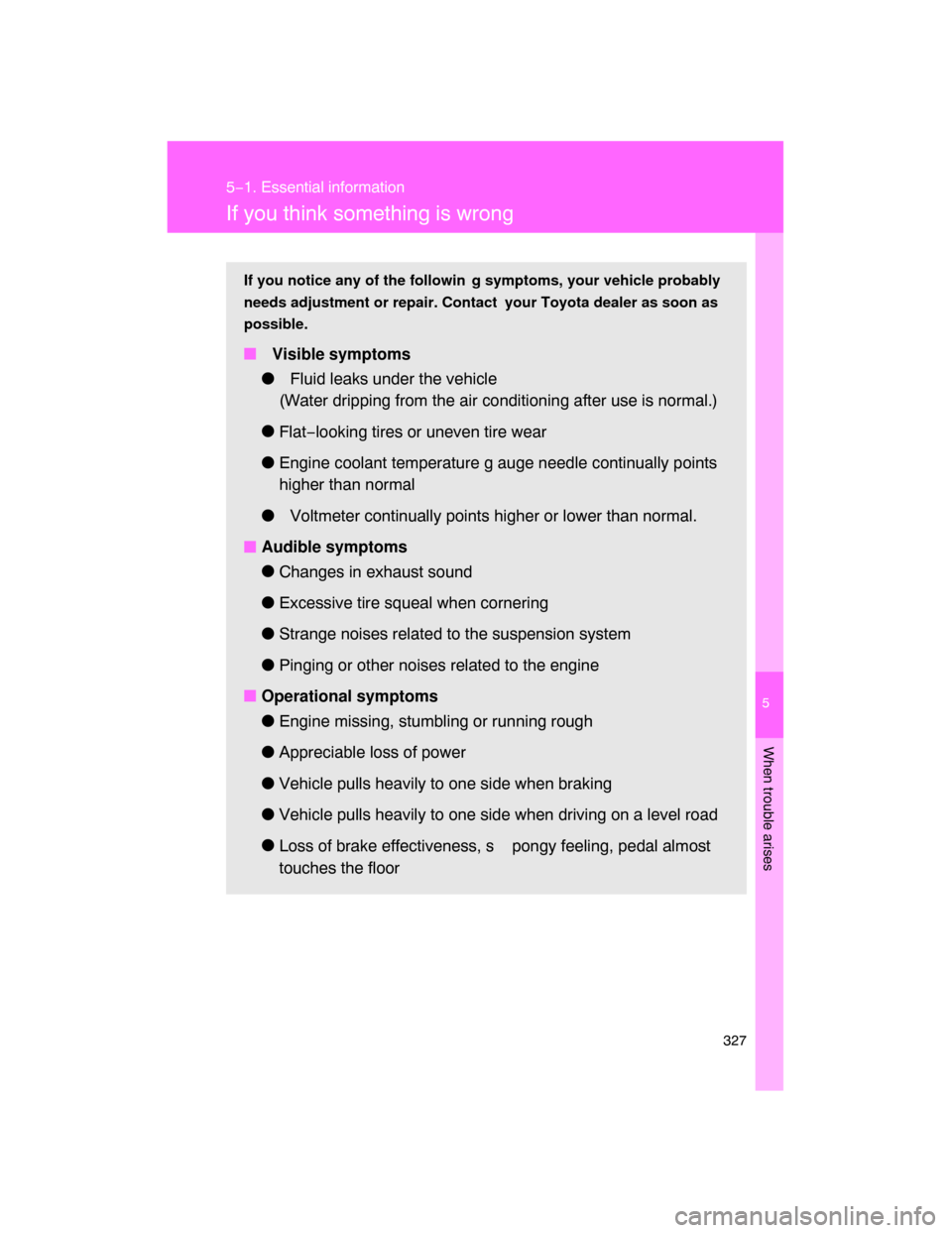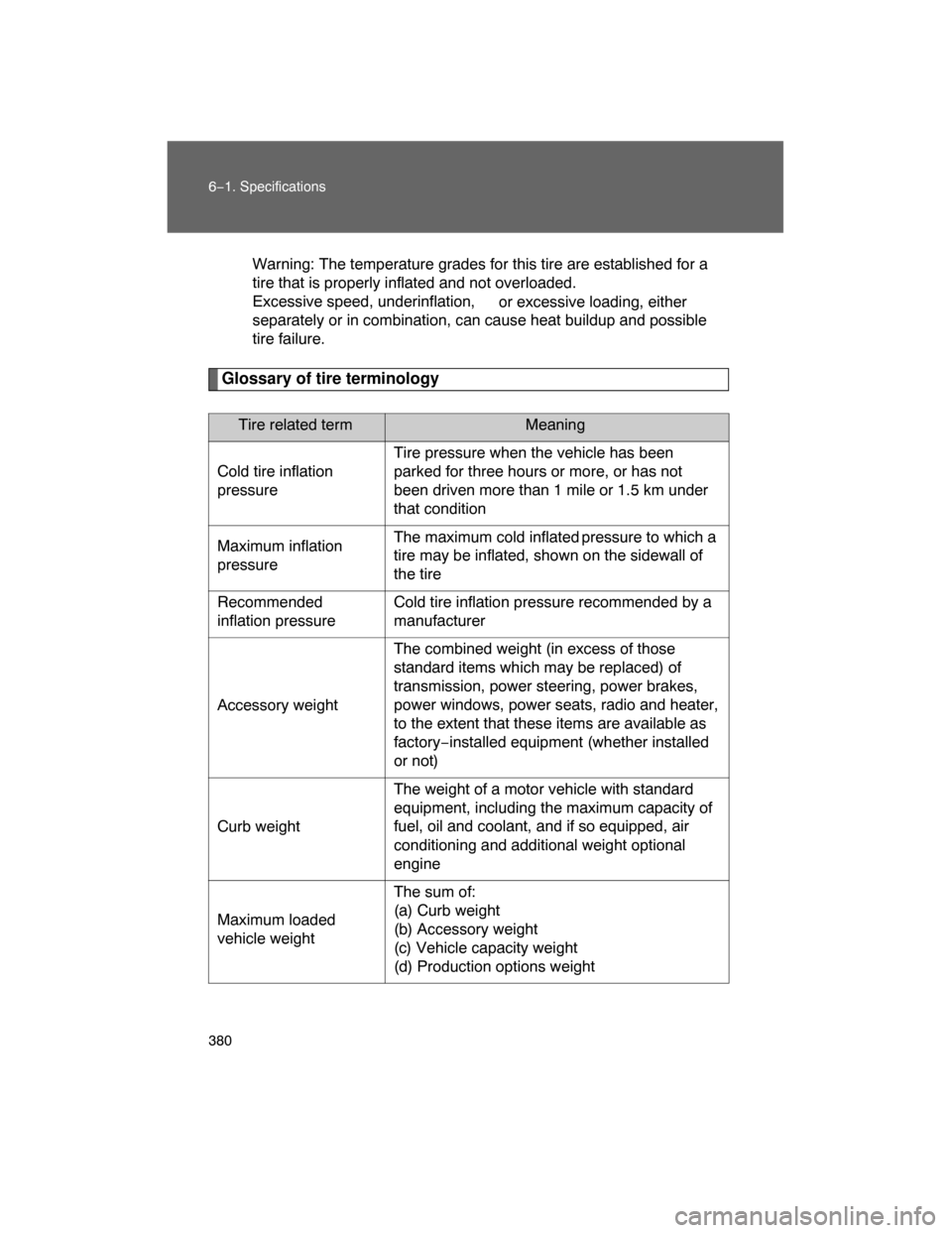Page 276 of 400
280 4−3. Do−it−yourself maintenance
Radiator and condenser
Check the radiator and condenser and clear any foreign objects.
If either of the above parts are ex
tremely dirty or you are not sure of
their condition, have your vehicle checked by your Toyota dealer.
Brake fluid
� Checking fluid level
The brake fluid level should be
between the MAX and MIN lines
on the reservoir.
NOTICE
� When adding engine coolant
Coolant is neither plain water nor stra ight antifreeze. The correct mixture of
water and antifreeze must be used to provide proper lubrication, corrosion
protection and cooling. Be sure to read the antifreeze or coolant label.
� If you spill coolant
Be sure to wash it off with water to prevent damage to parts or paint.
CAUTION
� When the engine is hot
Do not touch the radiator or condenser as they may be hot and may cause
burns.
Page 322 of 400

5
When trouble arises
327
5−1. Essential information
If you think something is wrong
If you notice any of the followin g symptoms, your vehicle probably
needs adjustment or repair. Contact your Toyota dealer as soon as
possible.
� Visible symptoms
� Fluid leaks under the vehicle
(Water dripping from the air conditioning after use is normal.)
�
Flat−looking tires or uneven tire wear
�Engine coolant temperature g auge needle continually points
higher than normal
� Voltmeter continually points higher or lower than normal.
�Audible symptoms
�
Changes in exhaust sound
�
Excessive tire squeal when cornering
�Strange noises related to the suspension system
�
Pinging or other noises related to the engine
�
Operational symptoms
�Engine missing, stumbling or running rough
�
Appreciable loss of power
�
Vehicle pulls heavily to one side when braking
�Vehicle pulls heavily to one side when driving on a level road
�
Loss of brake effectiveness, s pongy feeling, pedal almost
touches the floor
Page 352 of 400
5
When trouble arises
357 5−2. Steps to take in an emergency
The engine has cooled down sufficiently.
The engine coolant temperature gauge indicates C.
Check the engine coolant level.
Look for obvious coolant leaks
from the radiator, hoses and
under the vehicle.
Note that water draining from the air conditioning is normal if it has
been used.
Add engine coolant if required.
Water can be used in an emer−
gency if engine coolant is
unavailable. (
P. 366)
Have the vehicle checked at your nearest Toyota dealer as soon as
possible.
Page 353 of 400
358 5−2. Steps to take in an emergency
� Overheating
If you observe the following, your vehicle may be overheating.
�The engine coolant temperature gauge enters the red zone or a loss of
power is experienced.
� Steam is coming from under the hood.
CAUTION
� To prevent an accident or injury
when inspecting under the hood of
your vehicle
�Keep hands and clothing away from the fan and other belts while the
engine is running.
� Do not loosen the radiator cap while the engine and radiator are hot.
Serious injury, such as burns, may result from hot coolant and steam
released under pressure.
NOTICE
� When adding engine coolant
Wait until the engine has cooled down before adding engine coolant.
When adding coolant, do so slowly. Adding cool coolant to a hot engine too
quickly can cause damage to the engine.
Page 360 of 400
366 6−1. Specifications
Cooling system
Ignition system
Electrical system
Capacity
Vehicles with an automatic transmission
10.4 qt. (9.8 L, 8.6 Imp.qt.)
Vehicles with a manual transmission
9.9 qt. (9.4 L, 8.3 Imp. qt.)
Coolant typeUse either of the following.
�“Toyota Super Long Life Coolant”
�Similar high−quality ethylene glycol−based
non−silicate, non−amine, non−nitrite, and
non−borate coolant with long−life hybrid
organic acid technology
Do not use plain water alone.
Spark plug
Make DENSO
NGK
K20HR−U11
LFR6C11
Gap 0.043 in. (1.1 mm)
Battery
Open voltage at
68
F (20 C):12.6 12.8 V Fully charged
12.2 12.4 V Half charged
11 . 8 12.0 V Discharged
(Voltage checked 20 minutes after
the key is removed with all the lights
turned off)
Charging rates 5 A max.
Page 374 of 400

380 6−1. Specifications
Warning: The temperature grades for this tire are established for a
tire that is properly inflated and not overloaded.
Excessive speed, underinflation,
or excessive loading, either
separately or in combination, can cause heat buildup and possible
tire failure.
Glossary of tire terminology
Tire related term Meaning
Cold tire inflation
pressureTire pressure when the vehicle has been
parked for three hours or more, or has not
been driven more than 1 mile or 1.5 km under
that condition
Maximum inflation
pressureThe maximum cold inflated pressure to which a
tire may be inflated, shown on the sidewall of
the tire
Recommended
inflation pressureCold tire inflation pressure recommended by a
manufacturer
Accessory weightThe combined weight (in excess of those
standard items which may be replaced) of
transmission, power steering, power brakes,
power windows, power seats, radio and heater,
to the extent that these items are available as
factory−installed equipment (whether installed
or not)
Curb weightThe weight of a motor vehicle with standard
equipment, including the maximum capacity of
fuel, oil and coolant, and if so equipped, air
conditioning and additional weight optional
engine
Maximum loaded
vehicle weight
The sum of:
(a) Curb weight
(b) Accessory weight
(c) Vehicle capacity weight
(d) Production options weight
Page 388 of 400

396
Alphabetical index
Emergency, in case of
Blown fuse............................. 303
If the engine will not start ...... 350
If the shift lever cannot be
shifted from P...................... 351
If the vehicle battery is
discharged .......................... 353
If the warning buzzer
sounds ................................ 331
If the warning light turns on ... 331
If you have a flat tire ............. 340
If you lose your keys ............. 352
If you think something is
wrong .................................. 327
If the vehicle becomes
stuck ................................... 359
If your vehicle needs to be
towed .................................. 322
If your vehicle overheats ....... 356
Engine
Compartment ........................ 274
Engine switch ........................ 114
Exhaust gas .......................... 110
Hood...................................... 273
How to start the engine ......... 114
Identification number ............. 363
If the engine will not start ...... 350
Ignition switch........................ 114
Immobilizer system ................. 68
Overheating........................... 356
Warning light ......................... 331
Engine coolant
Capacity ................................ 366
Checking ............................... 279
Preparing and checking
before winter ....................... 169
Temperature gauge............... 124
Engine coolant temperature
gauge ...................................... 124
Engine immobilizer system....... 68
Engine oil
Capacity ................................ 365
Checking ............................... 275Preparing and checking before
winter .................................. 169
Warning light ................. 332, 334
Engine oil maintenance
data ......................................... 278
Engine switch........................... 114
Event data recorder ................. 329
Floor mat .................................. 247
Fluid
Brake..................................... 280
Washer.................................. 286
Four�wheel drive system
Four−wheel drive control
lever .................................... 144
Front−−wheel drive control
lever .................................... 146
Front passenger occupant
classification system .............. 85
Front passenger’s seat belt
reminder light ........................ 334
Front passenger’s seat belt
warning buzzer ...................... 334
Front seats
Adjustment .............................. 43
Front side marker lights
Replacing light bulbs ............. 317
Switch ................................... 131
Wattage................................. 371
Front turn signal lights
Lever ..................................... 121
Replacing light bulbs ............. 317
Switch ................................... 121
Wattage................................. 371
Fuel
Capacity ................................ 364
Fuel gauge ............................ 124
Fuel pump shut off system .... 328
Gas station information ......... 408
Information ............................ 372
Refueling ................................. 64
Type ...................................... 364
Warning light ......................... 334
E
F
Page 394 of 400
402
What to do if...
What to do if...
A tire puncturesP. 340If you have a flat tire
The engine does not start
P. 350If the engine will not start
P. 6 8Engine immobilizer system
P. 353If the battery is discharged
The shift lever cannot be
moved outP. 351If the shift lever cannot be shifted
from P
The engine coolant temperature
gauge enters the red zone
Steam can be seen coming
from under the hood
P. 356If your vehicle overheats
The key is lostP. 352If you lose your keys
The battery runs outP. 353If the battery is discharged
The doors cannot be locked
P. 3 3Side doors
P. 3 6Access doors
P. 3 8Back door
The vehicle is stuck in
mud or sandP. 359If the vehicle becomes stuck
The warning light or indicator
light comes onP. 331If a warning light turns on